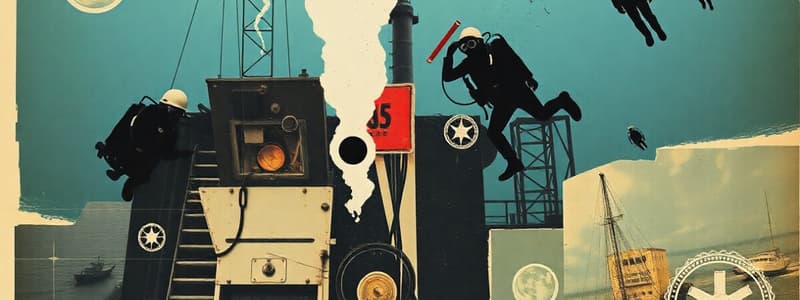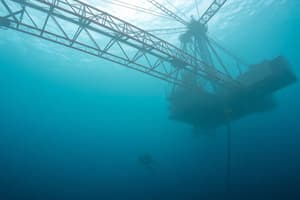Podcast
Questions and Answers
During the subsea spool tie-in operations, what primary factor led the Diving Supervisor to incorrectly assume the crane hook had reached the seabed?
During the subsea spool tie-in operations, what primary factor led the Diving Supervisor to incorrectly assume the crane hook had reached the seabed?
- Prior successful completion of similar operations under comparable conditions.
- The crane operator reporting 'no weight' on the crane wire. (correct)
- The diver's direct verbal confirmation despite limited visibility.
- A miscommunication regarding the weight limits of the crane.
Which of the following actions would be MOST effective in preventing a recurrence of the incident described?
Which of the following actions would be MOST effective in preventing a recurrence of the incident described?
- Requiring crane operators to undergo additional training on subsea lifting techniques.
- Implementing redundant communication checks between the dive supervisor, crane operator, and divers, along with the use of visibility aids. (correct)
- Increasing the frequency of pre-operation safety briefings to emphasize potential hazards.
- Mandatory use of enhanced personal protective equipment for all diving personnel.
What specific action related to Job Hazard Analysis (JHA) did the IMCA member take following the incident?
What specific action related to Job Hazard Analysis (JHA) did the IMCA member take following the incident?
- They mandated third-party review of all JHAs before commencement of operations.
- They updated the JHA to incorporate lessons learned, focusing on safe distances, visibility and communication. (correct)
- They eliminated subsea lifting operations from their scope of work.
- They implemented a new JHA system that included real-time risk assessment.
Besides poor visibility, what other factor directly contributed to the crane hook striking the diver's helmet?
Besides poor visibility, what other factor directly contributed to the crane hook striking the diver's helmet?
What immediate action demonstrated effective emergency response following the helmet strike?
What immediate action demonstrated effective emergency response following the helmet strike?
Flashcards
Subsea Crane Hook Incident
Subsea Crane Hook Incident
During subsea spool tie-in operations, a crane hook unexpectedly struck a diver's helmet due to misjudgment of the hook's position.
Cause of Crane Hook Incident
Cause of Crane Hook Incident
Crane hook was lowered for rigging disconnection and rested on the top beam of the PHF, resulted as 'no weight' reading, operator assumed hook at seabed. The hook slipped and struck the diver's helmet.
Contributing Factors
Contributing Factors
Insufficient crane pennant/stinger length and poor visibility hindered observation of the crane hook's position, causing the incident.
Safe Distance
Safe Distance
Signup and view all the flashcards
Enhanced Visibility
Enhanced Visibility
Signup and view all the flashcards
Study Notes
- During subsea spool tie-in operations, a crane hook struck a diver's helmet.
- The incident occurred on March 6, 2025.
What Happened
- Divers were working on the seabed with poor visibility during subsea spool tie-in operations.
- The Diving Supervisor instructed the crane operator to lower the crane hook to the seabed to allow the diver to disconnect rigging from the crane after landing the pipe handling frame (PHF).
- The crane operator reported no weight on the crane wire, so the Diving Supervisor assumed the hook had reached the seabed.
- While the diver was positioned beneath the PHF, the crane hook unexpectedly struck the diver's helmet.
- The diver reported no injuries and immediately returned to the dive bell.
- The dive was aborted and the diver's reclaim helmet was damaged beyond repair, including the side block.
- The helmet's integrity was maintained and the diver was unharmed.
What Went Right
- Diver 2 promptly assisted Diver 1 to ensure no injuries were sustained.
- Both divers immediately returned to the bell safely.
- Both divers and the crane block had locating beacons to enable accurate tracking.
- All procedures, lifting plans, and Job Hazard Analysis (JHA's) were followed throughout the operation.
- Protective equipment (helmet) absorbed the impact and prevented injury to the diver.
What Went Wrong
- The crane hook came to rest on the top beam of the PHF, resulting in a 'no weight' reading.
- The crane operator assumed the hook had reached the seabed.
- As the diver approached the disconnection point, the hook slipped off the beam and struck the side of the diver's helmet.
What Was The Cause
- Inadequate length of crane pennant/stinger: This did not provide sufficient distance between the divers and the crane hook.
- Poor visibility: This hindered the ability to accurately observe the position of the crane hook.
Lessons and Actions
- Ensure adequate distance between divers and the crane hook: The crane pennant/stinger should be long enough to maintain a safe distance between the divers and the crane hook during subsea operations to reduce the risk of accidental contact, especially in limited visibility conditions.
- Enhanced visibility aids and monitoring: Alternative methods such as additional locating beacons, underwater cameras, or sonar should be considered in environments with poor visibility to better track the position of critical equipment like the crane hook. Improved monitoring can prevent misjudgments about the location of the crane hook.
- Reinforce communications and challenge assumptions: Assumptions regarding equipment position should be minimised.
- Clear communication and confirmation procedures between the dive supervisor, crane operator, and divers should be reinforced so all parties are fully aware of the equipment's location at all times.
Steps Taken
- Project procedures were updated to specify minimum pennant lengths for different operations.
- Pre-operation inspections of all rigging and lifting equipment, including crane hooks and pennants, were conducted to ensure they meet safety standards.
- The Job Hazard Analysis (JHA) was updated to incorporate lessons learned regarding safe distances, visibility, and communication requirements for subsea lifting operations.
Studying That Suits You
Use AI to generate personalized quizzes and flashcards to suit your learning preferences.




